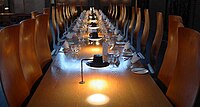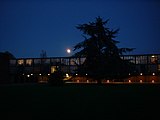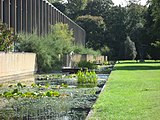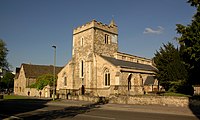St Catherine's College, Oxford
| St Catherine's College
| |||||||||||||||||||
|
Nova et Vetera | |||||||||||||||||||
|---|---|---|---|---|---|---|---|---|---|---|---|---|---|---|---|---|---|---|---|
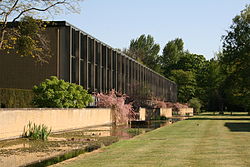
| |||||||||||||||||||
| Master: | Kersti Börjars | ||||||||||||||||||
| Website: | stcatz.ox.ac.uk | ||||||||||||||||||
| |||||||||||||||||||
| Location | |||||||||||||||||||
| Grid reference: | SP52200676 | ||||||||||||||||||
| Location: | 51°45’25"N, 1°14’42"W | ||||||||||||||||||
St Catherine's College (colloquially called St Catz or Catz) is one of the constituent colleges of the University of Oxford. In 1974, it was also one of the first men's colleges to admit women.[1] It has 528 undergraduate students, 385 graduate students and 37 visiting students as of December 2020, making it one of the largest colleges in either Oxford or Cambridge.
Designed by Danish architect Arne Jacobsen, the college was built in an egalitarian architectural style that maximises the number of rooms, for academically qualified students who lacked the financial resources to study at Oxford. In September 2023, access to areas of the college was restricted due to safety concerns around the use of Reinforced Autoclaved Aerated Concrete.[2][3][4]
The college developed out of the university's St Catherine's Society; it was granted full status as a college in 1962.
Contents
History
St Catherine's College Oxford traces its origins to 1868. In its first iteration, it was established as a delegacy for Scholares nulli Collegio vel Aulae ascripti ('Scholars enrolled in no college or hall'), by university statute on 11 June 1868.[5] This delegacy, informally known as the "Delegacy for Unattached Students", was created in response to the recommendation of a Royal Commission in 1850, that the university be open to a "larger and poorer" sector of the population.[6] The delegacy, by allowing students to enrol without belonging to a college, would enable less affluent men to gain an Oxford education without the costs of college membership.[7]
The delegacy appointed two of its stipendiaries, George Kitchin and George S. Ward, to be known as "Censors", to oversee the education and welfare of the students.[8] Nineteen students matriculated in October 1868 as Scholares nulli Collegio ascripti and were joined throughout the year by another forty, bringing the total number in the first year to 59.[9] Growing quickly, by 1872 the delegacy had admitted 330 students.[6] By 1914, more than 4,000 men had matriculated as non-collegiate students.[10] In 1884, the delegacy was renamed the "Delegacy for Non-Collegiate Students".[7]
In its first days, a room in the university's Old Clarendon Building was allocated for the operations of the delegacy, and with gifts of books from several donors, a library for the unattached students was installed there. These accommodations soon proved inadequate and in 1888, the delegacy was moved to a building in High Street next to the Examination Schools. Here the non-collegiate students, as they were known after 1884, had a library in its own dedicated space and two lecture halls. There was an administration office and rooms for the Censors and tutors. Designed by T. G. Jackson, this building is now the Ruskin School of Art. In 1936, the delegacy moved again, from its outgrown High Street premises to the limestone buildings on St Aldates, south of Christ Church, Oxford which are now part of the Oxford University's Faculty of Music.[6]
By 1956, the society had developed many of the characteristics of an Oxford college and the delegates decided to formalise this change in status by obtaining approval to turn into a fully residential college within the University of Oxford. After acquiring eight acres from Merton College on part of Holywell Great Meadow for £57,690, money was sought from the University Grants Committee who also agreed to supply £250,000 towards the building, and additional funds up to £400,000 for all facilities. By 1960, Alan Bullock raised a further £1,000,000 with assistance from two industrialists, Alan Wilson (whom he met by chance on the RMS Queen Mary) and Sir Hugh Beaver. After a total expenditure of £2.5 million, the college opened in 1962.
In 1974, St Catherine's was one of the first men's colleges to admit women as full members, the others being Brasenose, Jesus College, Hertford and Wadham.[11]
College name
In 1931, the delegacy officially acquired the name, "St Catherine's Society", with the current spelling. Variations of St Catharine having been used by the students for their sporting teams and various clubs since the 1870s, the name was already strongly associated with the delegacy. First forming a social club in April 1869, the students called it the "Clarendon University Club", taking that name from the Old Clarendon Building where the delegacy had been allocated a room. The students soon expanded their organised activities. By 1874 they began a more comprehensive association, which they called the St. Catharine's Club, after its headquarters, the hall where they dined and held meetings.[6] St Catharine's Hall was built around 1520 as a chapel, popularly called St Catherine's Chapel, (though officially "Chapel of Our Lady at Smith Gate").[12][13] Although deconsecrated, the 16th-century appellation of "St Catharine's" remained attached to the site throughout its later history.[14] The building's address at the time of the Club's tenancy was 29 Broad Street; it fronted, though, onto Catte Street, also known as Catherine Street from some point in the late 19th century until 1930—and first recorded as Kattestreete aroud 1210, Catte in 1402, Cate or Kate in the 17th century, and Cat or Catte again in the 1800s, the street's name enhancing the association with Catherine.[15]
In this way, the college became indirectly associated with the saint, Catherine of Alexandria. Despite the initially accidental relationship, St Catherine is celebrated as the college's patron saint "with a special Catz Night dinnerTemplate:Nbsp... at the end of which a giant Catherine wheel is lit in the quad". Other elements of this can be seen in the college blazon, which depicts four Catherine wheels, one of St. Catherine's attributes. While religious iconography can also be seen today in some of the college's symbols, the college's origins were largely secular.[16][17]
Buildings
Original buildings
The college is located to the east of central Oxford, on the banks of the Cherwell. Its buildings in glass, brick, and concrete, by the Danish architect Arne Jacobsen, marry modern materials with a traditional Oxford college layout centred on a quadrangle. Jacobsen designed everything, including the furniture, cutlery, lampshades, and the college gardens, down to the choice of fish species for the pond.
The original St Catherine's buildings are recognised as one of the world's most distinguished examples of modernist design, described by architectural historian Nikolaus Pevsner as "a perfect piece of architecture",[18] and said to have been the architect's personal favourite among his own works. Jacobsen's designs for the college have been the subject of various art and design exhibitions.[19] The original college buildings are Grade I listed. In 2020, the college gardens, also designed by Jacobsen, were upgraded to the highest level of protection by Historic England for historical and design interest.[20]
Jacobsen's plans for the college did not include a chapel, which is unusual among Oxford colleges: St Cross Church on the corner of Manor Road and Longwall Street served this purpose before being decommissed in 2008. The St Catherine's Christmas carol concert is now held in Harris Manchester College's chapel. The college has a bell tower, particularly visible since no college building is more than three storeys high.
St Catherine's has a number of lecture theatres and seminar rooms, a music house, two student computer rooms, a small gym, squash courts, a punt house, a Grade I listed bike shed[21] and among the most spacious common rooms in Oxford. There are also additional purpose-built conference facilities with lecture theatres, meeting rooms and bar, music room, and car parking available for non-students. The dining hall, which seats 350 diners, has the largest capacity of any Oxford college.[22]
Pictures
| ("Wikimedia Commons" has material about St Catherine's College, Oxford) |
Outside links
- St Catherine's College
- Virtual tour of Oxford. Produced by the Department of Chemistry, University of Oxford
References
- ↑ "Women Making History". http://www.ox.ac.uk/about/oxford-people/women-at-oxford.
- ↑ "University College restricts access in response to RAAC" (in en). 2023-09-08. https://www.oxfordmail.co.uk/news/23778356.oxford-university-college-restricts-access-due-raac/.
- ↑ Zaleski, Alexandra (2023-09-08). "RAAC at St Catherine's College" (in en-GB). https://www.stcatz.ox.ac.uk/raac-at-st-catherines-college/.
- ↑ "St Catz buildings closed due to RAAC concerns" (in en-GB). 2023-09-08. https://www.oxfordstudent.com/2023/09/08/st-catz-buildings-closed-due-to-raac/.
- ↑ "Stat. Tit. II. Sect. II. Cl. I" (in la). Addenda ad Corpus statutorum Universitatis Oxoniensis, sive: Pandectes constitutionum academicarum. 1869. p. 754. [NOTE: "The pagination follows that of the Corpus of 1768 and is continued by periodic additions"]. https://books.google.com/books?id=wT0JAAAAQAAJ&q=nisi+qui+in+aliquod+collegium&pg=PA754.
- ↑ 6.0 6.1 6.2 6.3 {{#invoke:citation/CS1|citation |CitationClass=encyclopaedia }}
- ↑ 7.0 7.1 "College History". https://www.stcatz.ox.ac.uk/about-us/college-history/.
- ↑ Trotman, R.R. & Garrett, E.J.K. The Non-Collegiate Students and St Catherine's Society 1868–1962 (Oxford University Press, 1962)
- ↑ Report of the Delegati ad aedes licentiandas, (Oxford, June 1869) pp. 6−7
- ↑ Bullock, Alan (2000). "7. 'A Scotch University added to Oxford'? The Non-Collegiate Students". in Brock, M. G.; Cuthoys, M. C.. Nineteenth-century Oxford: Part 2. The history of the University of Oxford. VII. Oxford: Clarendon Press. p. 207. ISBN 9780199510177.
- ↑ "Women at Oxford". University of Oxford. http://www.ox.ac.uk/about/oxford-people/women-at-oxford.
- ↑ National Heritage List 1369642: Hertford College, Chapel of Mary at Smith's Gate (Grade II listing)
- ↑ Template:VCH3
- ↑ "The Smith Gate and its Chapel". http://www.oxfordhistory.org.uk/city_wall/04_smith_gate.html.
- ↑ {{#invoke:citation/CS1|citation |CitationClass=encyclopaedia }}
- ↑ "Broad Street, Oxford: No. 29 — Former Octagonal Chapel". http://www.oxfordhistory.org.uk/broad/buildings/east/hertford/29.html.
- ↑ "Catte Street, Oxford". 8 September 2021. http://www.oxfordhistory.org.uk/high/tour/north/catte.html.
- ↑ Nikolaus Pevsner: The Buildings of England: Oxfordshire, 1974 Penguin Books ISBN 978-0-300-09639-2page 240
- ↑ "How to be Modern: Arne Jacobsen in the 21st Century". Modern Art Oxford. 20 April 2002. https://www.modernartoxford.org.uk/event/exhibition-8/. "This exhibition celebrated Jacobsen's enduring importance as one of the most significant architects and designers of the 20th century, including his designs for St Catherine's College, Oxford."
- ↑ National Heritage List 1001388: Landscape at St Catherine's College (Register of Historic Parks and Gardens)
- ↑ National Heritage List 1229973: St Catherine's College Bicycle Store (Grade I listing)
- ↑ "Buildings and Grounds – www.stcatz.ox.ac.uk". University of Oxford. https://www.stcatz.ox.ac.uk/college/buildings-and-grounds.
- Davies, M. & D. Creating St Catherine's College. Oxford: St Catherine's College, 1997. ISBN 0-9531279-0-7.
| Colleges of the University of Oxford | |
|---|---|
| Colleges:
All Souls • Balliol • Brasenose • Christ Church • Corpus Christi • Exeter • Green Templeton • Harris Manchester • Hertford • Jesus • Keble • Kellogg • Lady Margaret Hall • Linacre • Lincoln • Magdalen • Mansfield • Merton • New College • Nuffield • Oriel • Pembroke • The Queen's • Reuben • St Anne's • St Antony's • St Catherine's • St Cross • St Edmund Hall • St Hilda's • St Hugh's • St John's • St Peter's • Somerville • Trinity • University • Wadham • Wolfson • Worcester |
|
| Permanent private halls:
Blackfriars • Campion Hall • Regent's Park College • St Benet's Hall • St Stephen's House • Wycliffe Hall | |

